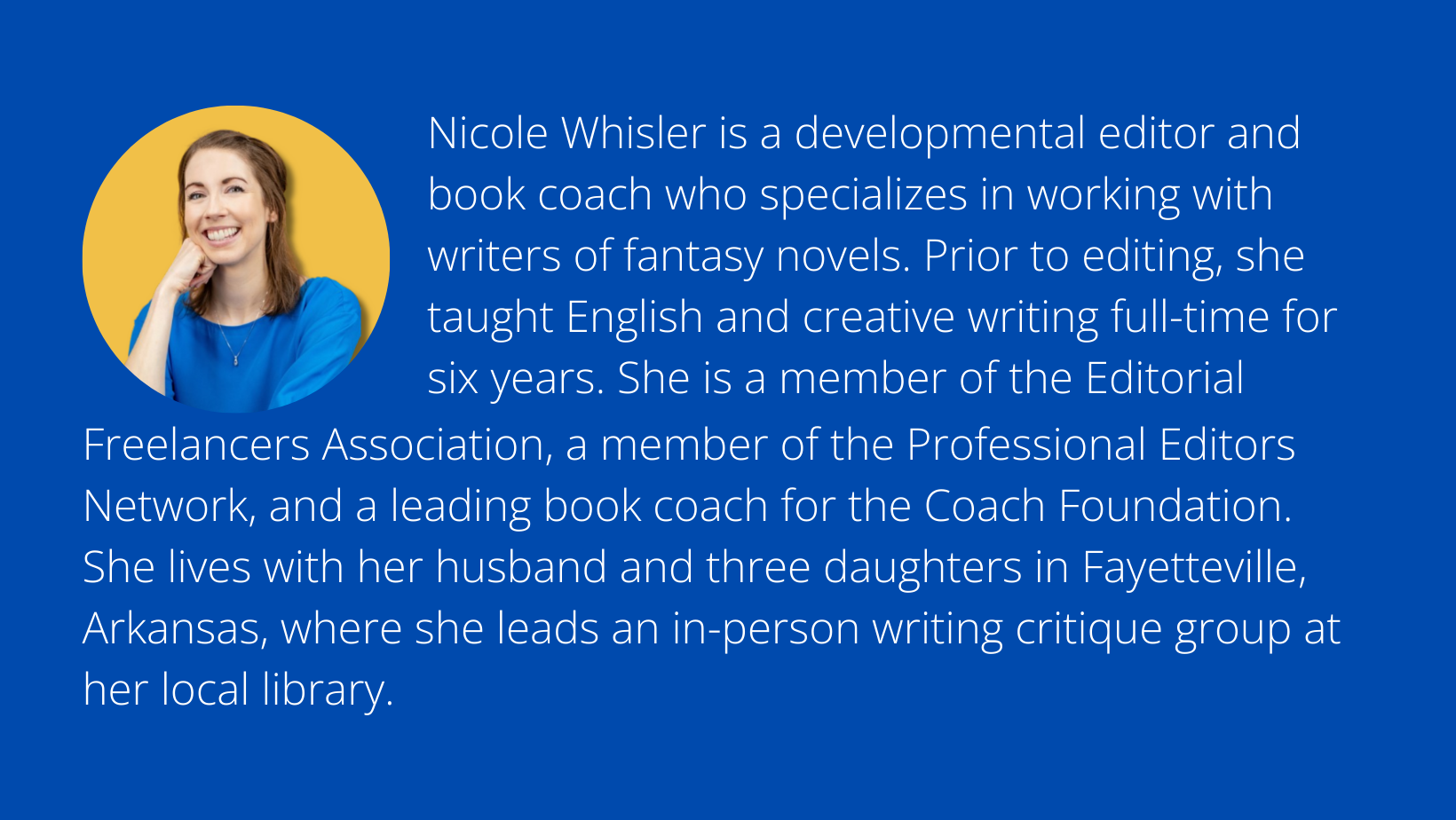Whisler Edits Blog

Crafting a Compelling Character
Discover in this post …
items to ignore when building your characters.
nine traits of a sympathetic, compelling protagonist.
a case study that displays how to make the most of the nine items.
A Recipe for Character Sympathy
If you surveyed a group of writers and asked them to describe how they construct the heroes of their stories, you’d get a variety of responses. You’d also discover, if you prodded further, that writers value different aspects of character creation. Some writers make wide claims about their hero’s individuality: “My protagonist will knock your socks off. He’s someone readers have never seen before. Guaranteed.”
Others go for the deep dive: “I know everything about my character. Favorite animal? Emperor penguin. Unique quirk? Fears the color yellow. Tragic backstory? Her grandmother’s neighbor’s friend was murdered by a second cousin.”
(If you’re ever at a loss for how to respond politely in cases like these, you might try, “I admire your enthusiasm.”)
The truth is, the most important ingredients in crafting a well-constructed character have nothing to do with uniqueness or with the number of notebooks you’ve filled with details of your character’s backstory. Rather, the ingredients relate to human nature at its core. Readers want to identify with a character. They want to see a combination of strengths and weaknesses—because that’s true to real life. They don’t want new. They want timeless.
There are nine specific items that make up a recipe for character sympathy, according to Eric Edson, acclaimed screenwriting professor, screenwriter, and author of The Story Solution: 23 Actions All Great Heroes Must Take. Edson proposes that integrating a minimum of five of the following nine ingredients—and including them as early as possible in your story—will establish a rich bond between readers and your hero. With this bond comes the goal of every writer: instilling in readers the compulsion to read on.

The following list of personality traits and story circumstances is taken, with permission, from The Story Solution. The explanations and examples are my own. For more writing advice from Eric Edson, check out his valuable website.
9 Ingredients to Consider
Here’s Edson’s recipe for crafting a sympathetic character, in order to lead to a compelling one:
1. Courage
A word that pairs nicely with this first trait is proactivity. Readers like to see heroes in action. They won’t stick around to watch what happens to Tim if he cowers in the corner for the majority of the book, or if he stands still while the action finds him. Tim needs to face the world—whenever possible, to act, not to react. To have a goal, and to pursue that goal. Can characters have fears? Of course. Can they refuse to face them for the entire novel? Not if you want readers to care.
2. Unfair Injury
If Christa clocks in an hour late at work and gets a smile from the boss, while you get a lecture for arriving two minutes late, that’s not cool. Your friends would be up in arms, making plans to let the air out of Christa’s tires during their lunch break. (Oh, you don’t have friends like that?) People have an innate sense of fairness, and when you mess with it, they notice, and they care. Eric Edson claims that the majority of successful movies start with the protagonist facing an Unfair Injury of some kind. Inflict injustice upon your protagonist, and watch as readers latch on to your hero from the start.
3. Skill
It’s fascinating to observe someone who is good at something. Not just good, but exceptionally skilled. If your boss is a jerk, but he’s also the most talented journalist you’ve ever met, you might be inclined to put up with his mannerisms because you hope his talent will rub off on you. Your protagonist should not be an expert at everything (no Mary Sue characters, please!) but needs to be good at something.
4. Funny
It’s hard to be intentionally witty. You probably don’t lie awake at night, trying to come up with humorous lines for your characters. (Or I don’t know, maybe you do.) Either way, it’s difficult to strike the right balance between humor and drama. If you can make a reader laugh and cry throughout your book (thank you, Patrick Rothfuss!)—well, that’s gold. Your beta readers or critique group will likely let you know if you don’t get this right. And that’s okay. Don’t force it. If it fits your story and your hero, let humor arise organically. And if not, don’t lose sleep over it. Better to lack humor than to insert a random Dad joke into each chapter. Yikes!
5. Just Plain Nice
Characters with genuinely good hearts are underrated. Your readers will bond with heroes who defend the weak, treat others with respect, and/or give generously of their time, money, or abilities. A little bit of kindness is sufficient. Your character doesn’t need to be Mother Teresa. And don’t worry—if your protagonist isn’t nice, you can make up for this missing trait with other items on the list.
6. In Danger
Putting your protagonist in danger early in your novel pays off in several ways. Dangerous situations trigger a reader’s sense of excitement (it’s fun to watch a perilous situation play out!) and of curiosity (how in the world will the hero survive?). Danger does not necessitate life-or-death circumstances. Failure, loss, and abuse fall into this category as well.
7. Loved by Friends and Family
If you don’t care much for Jake in Chapter 1, but a secondary character praises him in Chapter 2, you might view Jake in a new light. Maybe all you saw of Jake was a selfish loner, but the secondary character reveals him as a gentle, misunderstood soul. People have a range of qualities, and friends and family are often able to ignore surface qualities and unveil a person’s true self.
8. Hard Working
This trait goes hand in hand with proactivity. Your characters need to make things happen. In order to do that, they must pursue their goals in a direct way. This creates a sense of narrative drive, which introduces a cause-and-effect chain of events that keeps a story moving. Make sure your characters have clear goals, and make sure they don’t meander toward those goals. They run.
9. Obsessed
This final trait relates to character goals, just like #8. Have you ever spoken with great passion about a single topic, gesticulating widely and unaware of your volume, until your listener gives you a silent (or not so silent) signal that you’ve gone on too long? (Who? Me? Guilty.) This quality, while annoying in real life (although sometimes I’m super interesting…right?) can work beautifully in fiction. Not the long speech part. The committed part. Protagonists should care deeply about the paths they’ve chosen, and consequently, readers will too.
Those nine traits will give you a strong baseline for creating a sympathetic, compelling character. If you’re in doubt, take a look at how these items apply to Hugh Laurie’s rude but brilliant lead character, Dr. Gregory House, in the award-winning TV series House:

Courage - House acts without the knowledge or approval of his boss, Lisa Cuddy, in most episodes of the show.
Unfair Injury - Prior to the start of the show, House had a blood clot in his leg that caused some muscle and tissue to die. Rather than choose amputation, House opted for a risky surgery that didn’t work. Doctors cut out the dead muscle, leaving House in constant pain.
Skill - House has an incredible depth of knowledge related to rare medical conditions and diseases. His character role was written as a medical adaptation of Sherlock Holmes.
Funny - House is witty, sarcastic, and hilarious in a way his patients don’t appreciate—but viewers do.
Just Plain Nice - Nope. House isn’t nice.
In Danger - Although in most episodes, House’s patients are in far more physical danger than he is, House regularly undergoes threats from his boss to keep him in line. The show also contains a number of special episodes in which House or someone he cares about faces life-or-death circumstances.
Loved by Friends and Family - Wilson, played by Robert Sean Leonard, acts as House’s loyal friend, standing by when others abandon House for his selfish behavior or risky decisions.
Hard Working - When there’s an interesting case to solve, you’ll find House buckling down and giving everything he’s got. When he thinks a case is beneath him, well—you might find him bouncing a ball against the wall (although sometimes this helps him think) or investing his time in some random, immature activity.
Obsessed - The more difficult a case is to solve, the more it consumes House. Even when others insist they’ve found the correct diagnosis, House pursues his own ideas with a fiery passion. He isn’t always right, but he’s always relentless.
Wow! Eight out of nine. No wonder Hugh Laurie won two Golden Globes. And no wonder House was the most watched fictional TV show in the world in 2008.
Mix and Match
The truly fun part comes in when you decide how you want to mix and match the nine items. Brandon Sanderson, #1 New York Times best-selling author of novels like Mistborn and The Way of Kings, has created a system involving three sliding scales of character:
1) proactivity,
2) competence, and
3) likeability.
Huh—interesting if you look at these scales in terms of the above items. Proactivity equates to courage, competence equates to skill, and likeability more or less encompasses the rest. Sanderson explains that you can dial each of these sliding scales up or down, depending on your desired effect. For more about this topic, you can watch Sanderson’s YouTube lecture about these sliding scales. You can also read this informative blog post, written by September C. Fawkes, prior assistant to the New York Times best-selling author David Farland. Fawkes’s post analyzes Sanderson’s sliding scales and provides further examples of their use.
There you have it, folks! Nine personality traits and story circumstances that will keep readers turning pages (or, if you’re a screenwriter, glued to the screen). Use the same list to give even your archvillains true human depth and recognizable human motives.
Consider how a recipe works in the kitchen. If you include the desired ingredients and mix them together as instructed, you have a decent chance of making something delectable. And if you feel the urge to add further items to the list—well, many of the greatest recipes evolve over time. Feel free to experiment!
Examine the characters in your current story. How many of these nine ingredients align with your hero? In what other ways does your protagonist stand out? Do some of these traits make you think of characters from your favorite novels, TV shows, or movies? Let me know in the comments below!
Do you want to learn how to write a story that makes your target readers stand up and cheer? If you’d like support from A to Z (from brainstorming to drafting to revising to publication), book a Discovery Call with me to see if you’re a good fit to join my book coaching program, Fantasy Footsteps: Road to Publication. And if you haven’t done so already, grab your Free Guide on how to hook readers from your story’s start!

